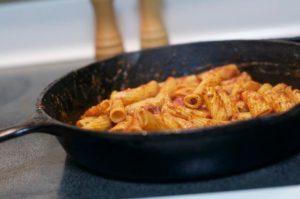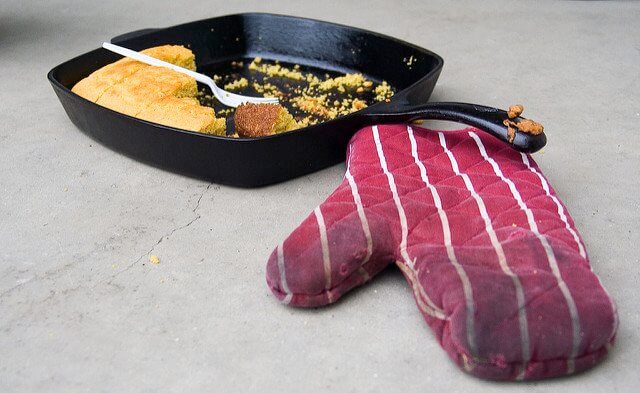
Finding rust on a beloved or forgotten piece of cast iron can be an unpleasant experience. Maybe it’s a piece that has been in your family for a while and everyone forgot. Maybe you finally cleaned out that back cupboard in the kitchen and found an old cast iron skillet that you haven’t used in ages.
No matter what the cast iron piece is, getting rust off of it is usually a pretty easy process. But it’s going to take a little bit of elbow grease.
Step 1 – Scrub
The first part of this process is going to be the hardest. You’ve got to scrub that rust off.
The easiest and most effective tool for this is usually steel wool. It’s got a nice fine scrubbing action that will help get all the tiny bits of rust off without you having to work so hard.
Fine steel wool is best. Get it at Amazon.
You may end up wanting to alternate between steel wool and a bigger scrubbing brush, if you find that the steel wool isn’t getting it all off in one go.
This is the hardest part, but also the most important! Make sure to get the whole pan back to its original lovely cast iron self.
Step 2 – Wash
Now you’ve got the cast iron back to looking like itself, and the rust is gone. The next step is to wash it like you normally would. Use a mild dish soap and a sponge to wash off any rust, steel wool, and dirt fragments.
This part of the process is just like washing any other pan. Give it a good wash with warm water and soap, and you’ll be ready to continue restoring the cast iron.
Here’s an unscented dish soap from Amazon.
If, after you’ve washed it, you notice that there are still some bits of rust, go ahead and scrub them again with steel wool. You can repeat steps 1 and 2 as many times as you need to until all the rust is gone.
Once you’ve washed the pan and are sure the rust is off, you’re ready to move to step 3.

I made a list of my favorite posts about cast iron.
Step 3 – Dry
Dry the cast iron pan off completely with a clean dish cloth or paper towels. Unlike a different kind of pan, you must dry cast iron immediately after washing. This will help prevent it rusting in the future!
Amazon has some cool dish towels that dry well.
Step 4 – Seasoning
This next step of the process is part of what makes cast iron pans so special. After washing and drying, give your cast iron a treatment with oil. This sounds fancy, but is actually very simple.
Take your favorite cooking oil and pour a small amount into the pan (about the size of a quarter). Use a paper towel to rub the oil into the pan, even over the back side of it and the handle. This seasons the iron and keeps it well conditioned, so it will last for a good long time.
There are a lot of opinions out there on what the “best” oil is for seasoning a cast iron pan. Some people say flaxseed oil is the most consistent and reliable. Others swear by vegetable oil or canola oil. And still others use bacon grease.
As you use your cast iron pan more, you may find you develop a favorite oil to season your pan with, but for now, just use something you have around the house. Most people will agree that any oil will get the job done.
Read more in my Definitive Guide to Seasoning Cast Iron.
Step 5 – Baking
Baking your pan is another uniquely cast iron-specific step of the maintenance and cleaning process. After treating the pan with oil, bake it in the oven at 350 degrees for an hour. You can place the pan directly on the baking rack in the oven, upside down.
You may want to put a pan or a sheet of tin foil on the rack underneath the rack the pan sits on to catch any dripping oil.
Don’t have a cast iron pan? Get one from Amazon.
Step 6 – Cooling
The easiest of all the steps. Allow your pan to cool in the oven for about an hour after you have turned it off. Be careful when you first turn the oven off, as the pan will be very hot. Use oven mitts.
Other cleaning options
These steps will help you restore a piece of cast iron that has rusted. If the problem is really bad and you find that you can’t scrub it off with steel wool, you may want to take it to someplace that can sand blast off the rust, like a machine shop.
Luckily, you can deal with most rust problems at home following the steps described above.
Prevention
Most of the time a skillet rusts from exposure to too much moisture. Making sure to follow the normal care and maintenance steps for a cast iron skillet can help to make sure that rust doesn’t become a serious problem. Remember to season it with oil and bake it.
However, even when rust does appear on a beloved cast iron piece, the steps described in this article can help make sure your skillet or pan is useable for many more years to come!
Pizza in cast iron? Yes you can. Get the recipe here.




